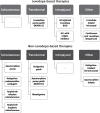Continuous Drug Delivery Aiming Continuous Dopaminergic Stimulation in Parkinson's Disease
- PMID: 30584160
- PMCID: PMC6311379
- DOI: 10.3233/JPD-181476
Continuous Drug Delivery Aiming Continuous Dopaminergic Stimulation in Parkinson's Disease
Abstract
Continuous dopaminergic stimulation in Parkinson's disease (PD) has several advantages over pulsatile, non-continuous, stimulation. These therapies currently consist of pump-based and transcutaneous therapies and are based on a more constant delivery of the dopaminergic drug resulting in continuous dopaminergic stimulation and a more stable treatment effect. Several clinical and experimental observations have shown that continuous stimulation of dopaminergic receptors induces fewer complications, such as dyskinesia, compared to pulsatile stimulation. Currently available non-oral pharmacological continuous therapies in PD include the transdermal Rotigotine (RTG) patch, infusion therapies with Apomorphine and Intrajejunal Levodopa (IJLI) and the Rivastigmine patch. Here we aim to provide a concise review of these current therapies and discuss ongoing and future developments of continuous non-oral pharmacological dopaminergic therapies in PD.
Keywords: Parkinson’s disease; apomorphine; infusion pumps; rivastigmine; rotigotine.
Figures
References
-
- Olanow CW, Obeso JA, Stocchi F (2006) Continuous dopamine-receptor treatment of Parkinson’s disease: Scientific rationale and clinical implications. Lancet Neurol 5, 677–687. - PubMed
-
- Bibbiani F, Costantini LC, Patel R, Chase TN (2005) Continuous dopaminergic stimulation reduces risk of motor complications in parkinsonian primates. Exp Neurol 192, 73–78. - PubMed
-
- Rascol O, Brooks DJ, Korczyn AD, De Deyn PP, Clarke CE, Lang AE (2000) A five year study of the incidence of dyskinesia in patients with early Parkinson’s disease who were treated with ropinirole or levodopa. N Engl J Med 342, 1484–1491. - PubMed
-
- Nutt JG, Obeso JA, Stocchi F (2000) Continuous dopamine receptor stimulation in advanced Parkinson’s disease. Trends Neurosci 23, 109–115. - PubMed
-
- Titova N, Schapira AHV, Chaudhuri KR, Katunina E, Jenner P (2017) Nonmotor symptoms in experimental models of Parkinson’s disease. Int Rev Neurobiol 133, 63–89. - PubMed
Publication types
MeSH terms
Substances
LinkOut - more resources
Full Text Sources
Medical


